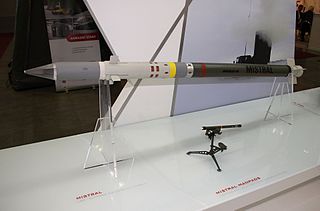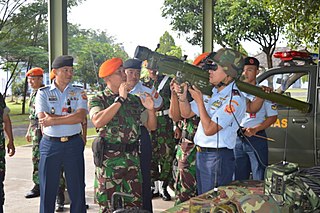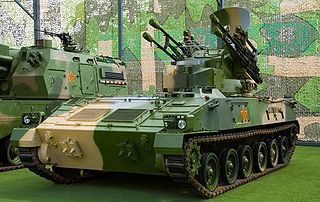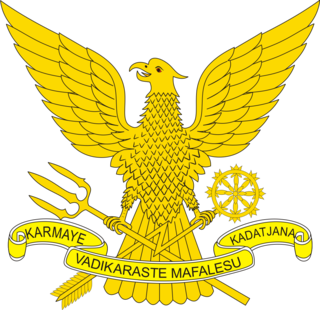
The FIM-92 Stinger is a man-portable air-defense system (MANPADS) that operates as an infrared homing surface-to-air missile (SAM). It can be adapted to fire from a wide variety of ground vehicles and helicopters. Developed in the United States, it entered service in 1981 and is used by the militaries of the United States and 29 other countries. It is principally manufactured by Raytheon Missile Systems and is produced under license by EADS in Germany and by ROKETSAN in Turkey, with 70,000 missiles produced.

The 9K32 Strela-2 is a light-weight, shoulder-fired, surface-to-air missile system. It is designed to target aircraft at low altitudes with passive infrared homing guidance and destroy them with a high explosive warhead.

Mistral is an infrared homing MANPADS manufactured by the European multinational company MBDA missile systems. Based on the French SATCP, the portable missile later to become the Mistral began development in 1974. It was initially deployed in 1988 for the first version (S1), 1997 for the second version (M2), and 2019 for the third version (M3).

Man-portable air-defense systems are portable surface-to-air missiles. They are guided weapons and are a threat to low-flying aircraft, especially helicopters.

The 9K35 Strela-10 is a highly mobile, short-range surface-to-air missile system. It is visually aimed, and utilizes optical/infrared-guidance. The system is primarily intended to engage low-altitude threats, such as helicopters. "9K35" is its GRAU designation; its NATO reporting name is SA-13 "Gopher".
The HN-5 is a family of first generation Chinese man-portable air-defense systems (MANPAD) based on Soviet technology. The HN abbreviation is used to avoid confusion with HY series anti-ship missiles of Silkworm missile family. The HN-5 series in Chinese hands has been phased out in front-line and first line reserve units by QW series MANPAD, but still being used by militia units.

The Anza is a series of shoulder-fired, man-portable surface-to-air missiles produced by Pakistan. Guided by an infrared homing seeker, the Anza is used for short range air defence.

The HQ-7 (FM-80) is a Chinese short-range low altitude air defense missile reverse engineered from the French Crotale. The missile is deployed on both ships and land-based vehicles. China revealed the export version, FM-80, in the 1989 Dubai Air Show. Unit cost is around $162,000 per launcher and $24,500 per missile.

The Misagh-1 is an Iranian man-portable surface-to-air missile. It was developed by the Shahid Kazemi Industrial Complex in Tehran.

The People's Republic of China-developed QW-1 Vanguard is an all-aspect man-portable surface-to-air missile, from which a series of missiles were developed.

An infrared countermeasure (IRCM) is a device designed to protect aircraft from infrared homing missiles by confusing the missiles' infrared guidance system so that they miss their target. Heat-seeking missiles were responsible for about 80% of air losses in Operation Desert Storm. The most common method of infrared countermeasure is deploying flares, as the heat produced by the flares creates hundreds of targets for the missile.

The HQ-9 is a long-range semi-active radar homing (SARH) surface-to-air missile (SAM) developed by the by the People's Republic of China. The naval variant is the HHQ-9.
The PL-9 is a short-range, infrared-homing air-to-air missile (AAM) developed by the People's Republic of China. It was originally designed by Dong Bingyin (董秉印) at the Luoyang Electro Optical Center, which is also known as Institute 612 and renamed in 2002 as the China Air-to-Air Guided Missile Research Institute (中国空空导弹研究院). After Dong Bingyin died, his position was succeeded by Mr. Jin Xianzhong (金先仲). The deputy general designer of PL-9 is the same deputy general designer of PL-12, Dr. Liang Xiaogeng (梁晓庚).
TY-90 is a Chinese air-to-air missile specifically developed for attack helicopter dogfights. Contrary to the erroneous claims, the missile is not developed from MANPADS missiles such as QW-1 Vanguard, but instead it is designed as an air-to-air missile from the start. It is the world's first helicopter-specific air-to-air missile.

The Type 95 is a Chinese self-propelled anti-aircraft vehicle. It is armed with four 25 mm caliber cannons and optionally four fire-and-forget QW-2 infrared homing missiles. It was first displayed publicly at the Beijing Military Parade in 1999. Earlier in development the system was designated Type 90-II and Type 90-III.
FN-6 or Feinu-6 is a third generation passive infrared homing (IR) man portable air defence system (MANPADS). It was developed by China, and is their most advanced surface-to-air missile offered in the international market. Specially designed to engage low flying targets, it has a range of 6 km and a maximum altitude of 3.8 km. The FN-6 is in service with the People's Liberation Army (PLA), and has also been exported to Malaysia, Cambodia, Sudan, Pakistan and Peru. Based on FN-6, China has developed a number of other MANPADS, such as HN and FY series, as well as other vehicle-based short-range air defense systems such as FN and FB series.

A missile approach warningsystem (MAW) is part of the avionics package on some military aircraft. A sensor detects attacking missiles. Its automatic warning cues the pilot to make a defensive maneuver and deploy the available countermeasures to disrupt missile tracking.

United States Army air defense relies on a range of ground launched missiles ranging from hand held to vehicle mounted systems. The Air Defense Artillery is the branch that specializes in anti-aircraft weapons. In the US Army, these groups are composed of mainly air defense systems such as the PATRIOT Missile System, Terminal High Altitude Air Defense, and the Avenger Air Defense system which fires the FIM-92 Stinger missile.

The Paskhas is the air force infantry and special forces corps of the Indonesian Air Force. The corps is also known as the Orange Berets from the colour of their service headgear. Paskhas is trained to seize and defend airfields from enemy forces known as Operasi Pembentukan dan Pengoperasian Pangkalan Udara Depan , airborne operations, and other specific military operations within the scope of the Indonesian Air Force.

The 9K333 Verba is a Russian fourth-generation man-portable infrared homing surface-to-air missile (SAM) MANPADS. "9K333" is the Russian GRAU designation of the system. Its NATO reporting name is SA-25.
















